- This topic has 178 replies, 6 voices, and was last updated 4 years, 6 months ago by
Giulio TiberinI .
-
AuthorPosts
-
6 January 2018 at 13:38 #10676
@Giulio
So I take it you have no choice,I have to renounce my way to dig glass?The problem is that if I go back again to previous trouble will tend to score the surface…This will result in more time.
Are you sure that if I proceed with 800 It does not solve?
Do I have to go back to 500?
The solution of Gugolz pitch would avoid the tool plaster / glue?
Surely I will not risk breaking the glass so I will avoid the plaster cast…I might try the glue tiler!@Maximum
the glass is currently in phase 1, if the test was suitable I would definitely prepared the tool with pitch…it seems I have to go back.
To try again test these days being careful opening slot!
Why do you claim that the test in step 1 You can not do?
I can assure you that the surface is so smooth to also reflect a very dim light.
Thank you

 6 January 2018 at 15:00 #10677
6 January 2018 at 15:00 #10677Change is not obbligatotio, and you may well continue like, experimentally to see if the continuation of the work can improve the surface multi astigmatic that you now have in place a simple sphere.
It calculates that a sphere is easy to achieve with the standard mode of work that make use of a rigid tool full diameter, with abrasive powder, used wet, while a dry work is also dangerous for the silicosis risk caused by harmful inhalation of glass powder.If you will not do it to make the simple sphere with your method, you will have time and opportunity to change, fabbricandoti a tool full diameter, Injected curvature of your existing mirror.
Obviously, if you come back on the road Orthodox standards and realization, crossed by thousands of people over the last two hundred years, you will like them easier to achieve the goal.
In that case, per achieving the scope, on the tool you'll need to paste the famous stoneware piastrelline, or the glass pieces, and use wet the abrasive powder.
The solution of Gugolz pitch would not prevent the tool manufacturing gypsum / glue, because the pitch, however, requires its unstallazione on a tool, after the ball has been produced, to polish.
6 January 2018 at 15:10 #10679and Luke, the degree of sanding generated by grit 800 unfortunately it is not sufficient for a correct reflection. If you look at your microscope with the surface, however, you will see the tiny craters which have still larger than the wavelength of light, this means that the light incident on the glass wave is reflected in several directions. For this reason you can not do the Ronchi test, since the reflected light is diffused light, while we need that the reflection occurs in the focal plane for examining the characteristics.
When the glass is polished to the point that we can see his own reflection, then you can execute the Ronchi test, but this may not occur before the passage of cerium oxide with pitch tool.18 February 2018 at 1:05 #10755Hello forum,
These days I made several attempts to correct the multiple surface astigmatism that I am after months of work, Unfortunately, the result was not the best, I think it depends on the tool in use, too small!
So I decided to create a new much larger tool (diameter 35 cm), almost as much as the size of the mirror using as raw material wood with a thickness of at least 2 cm.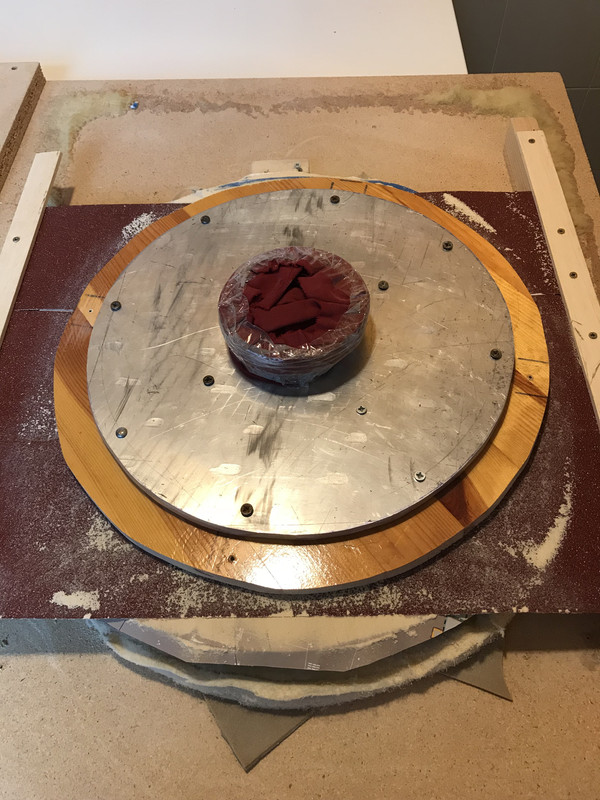
I tried to mold this wooden support rubbing on the surface of the mirror that I covered with sandpaper (obviously this operation before the mirror preferred paste on a layer of paper type of surface that the printer having a thickness of about 2 tenths of a millimeter in order to avoid possible scratches), I started with the grain 40 until then to end 400, obtaining a very smooth and adherent surface as possible.
The tool seems well managed, if it is based on the mirror it is a kind of suction effect, is completely sticks to the glass.
Then I tried to attack the tool with sandpaper spray glue to adhere to the support as much as possible and have a more precise form.
Gia from the first minutes of work can be seen more opaque glass pieces in different areas, Probably the glass in that part of them appeared higher (I think).
If I did a good job with the tool should be able to correct astigmatism Ball, I have no idea how long I serve to straighten the surface, The delicate point is that I have returned to a more coarse-grained (400)as it had been suggested by Giulio.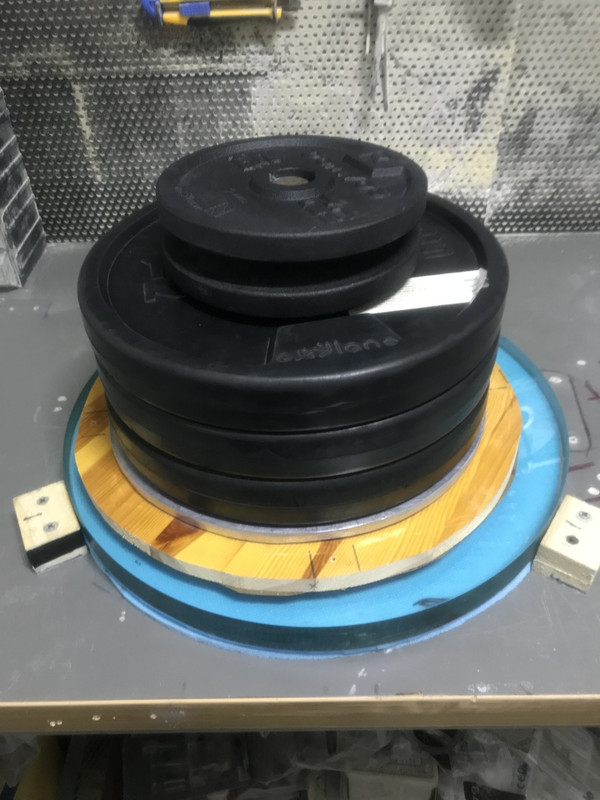
Given the dimensions of the tool you need to use weight to exert strong pressure at work and place discs from the gym above the tool, make racing 1/3 COC turns out to be the most conventional technique for obtaining a good spherical shape and correct defects.
We'll see how everything evolves.See you later
:Goodbye:18 February 2018 at 14:22 #10756Hello geminimac.
I would say good. In the sense that the choice to carry out a full-diameter tool is the first step to ensure a spheroid sufficiently uniform.
I think it would have been a little better achieve the tool really full diameter and no larger, (or once the difficulties of realization exceeded, resize it to the full diameter) because in achieve a greater diameter it is more difficult to get to have the same curve up to the edge, which among other things is the area with the tolerance of smaller final machining, that is, 68,75 millionths of a millimeter.However I am confident that the award will disappear astigmatism with the use of your tool. If not you can always reduce its diameter to that of the mirror.
I also believe that one of your problems is to use sandpaper instead of scouring powder. Why sandpaper “It makes rows”, while the abrasive powder makes the craters, that are more than a million times easier to eliminate in order to obtain the smooth surface to the degree necessary.(…seen those crazy infinitesimal tolerances).
Another problem is that the abrasive paper abrade only a surface at a time: That is, if the mirror is fixed, abrade only the tool, and vice versa if it is applied to the tool only the mirror abrade…While approaching the tolerances of those few millionths of a millimeter must use the abrasive powder, that abrade the one and the other surface contemporameneamente making one and the other complementary and identical.As I said, the experimental road is not absolutely forbidden, but it is longer and absolutely insecure.
If you decide, you can always “return to the fold” experienced the classic method and, cutting the tool to the mirror diameter; then paint it all epoxy, and finally glue on its work surface, always with epoxi, a lot of glass plate pieces, in a disorderly way and without large “holes”. And finally converting you to the use of wet abrasive powders, all that will securely uniforms the two surfaces, leaving on the mirror roughness but not rows of craters.
(Always keep in mind that a “line” (ie a groove) long even if only one centimeter (that is 10000 microns), left on the glass from dragging of grit sandpaper 800 (which has an average diameter of 20 microns), creates a defect at least (10000/20)= 500 times more difficult to remove than the single crater left by an abrasive grain that affects disorderly. While a row instead makes one big injury comparable to a long and ordered sequence of craters).
18 February 2018 at 18:59 #10765So the tool I made (35 cm) and smaller than the diameter mirror that counts 41 cm…Perhaps you're confused but does nothing (or maybe I misunderstood me).
Meanwhile I try to correct astigmatism in this way then I'll see if they change course.According to you if you were using the cerium oxide with the pitch tool consumerei more surface than would the abrasive paper 800?
thank you
See you soon
 18 February 2018 at 19:33 #10766
18 February 2018 at 19:33 #10766Ah, right! You excuse me. I confused me with a 300.
No, I believe that the cerium oxide scratch still very little because it has a grain of a few microns, while 800 It is coarser, and then dig more.
18 February 2018 at 19:57 #10768Thanks
 6 August 2019 at 22:23 #11497
6 August 2019 at 22:23 #114976/8/19, Replaced in visibility all the photos he had changed the server PostImage
7 August 2019 at 12:25 #11501Fine thanks

 20 February 2020 at 15:59 #11679
20 February 2020 at 15:59 #11679hello Forum!
After several months of hard work I take stock of the situation.
As written in previous posts I have created a tool (35 cm in diameter)molded in the shape of the mirror in question(41 cm).
I tried to erase the multi-astigmatic areas from the surface as shown in previous photos with 1 / 3D center on center strokes.
The grinding work was not done exactly with the traditional methods required (i.e. abrasive corundum powder), but using abrasive paper attached to the tool, I have come to work the surface with grain 1000.
Now the mirror is very opaque, instead before during grit processing 800 he was very lucid, the surface reflected enough light to suggest a Ronchi test.
So I need to move on to polishing hoping that I don't have to go back to grinding again.
For the step concerning the pitch tool I tried to create one by pouring the pitch on an aluminum support from 1 cm thick, should be enough to keep it from deforming during processing (although I'm not sure if that's okay since aluminum is a metal that is easily affected by temperature changes).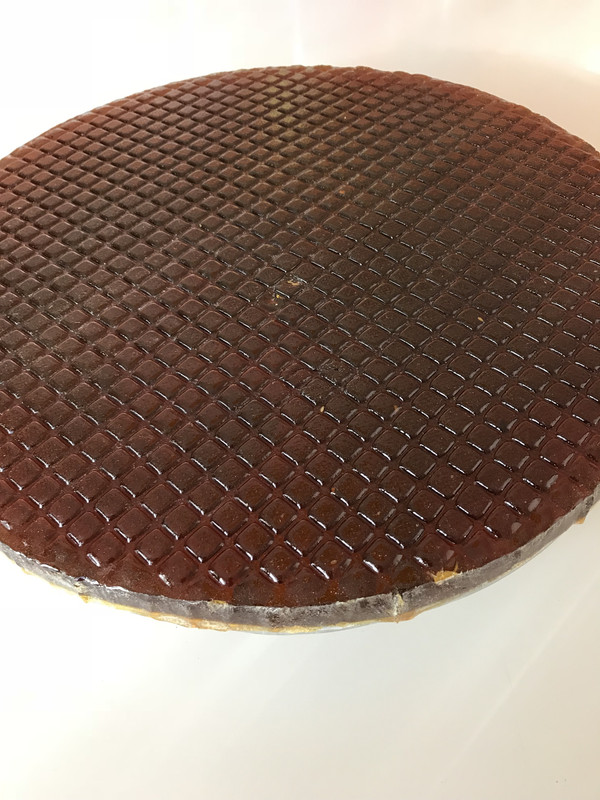
However I still have to decide for the final hardness to give to the pitch.
I made a mix of rosin + turpentine(to try), I didn't consider beeswax.
It is essential to add beeswax to the mix or just turpentine is fine to give the dough the right consistency?
I read a post where the nail test is indicated to determine the hardness of the mixture but I did not understand what it is. (I suppose you have to mark the surface of the pitch with your fingernail?)
Here are some photos with 100X magnification that show the surface in the central part and on the sides.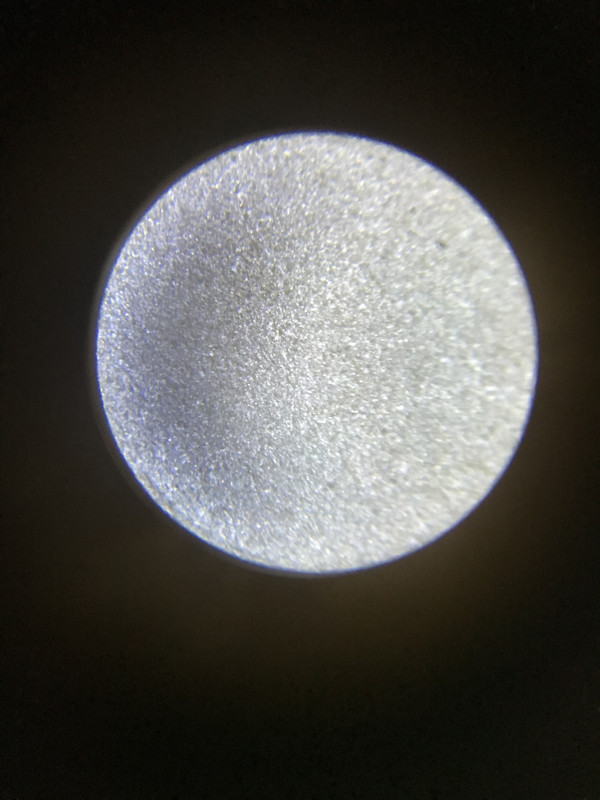
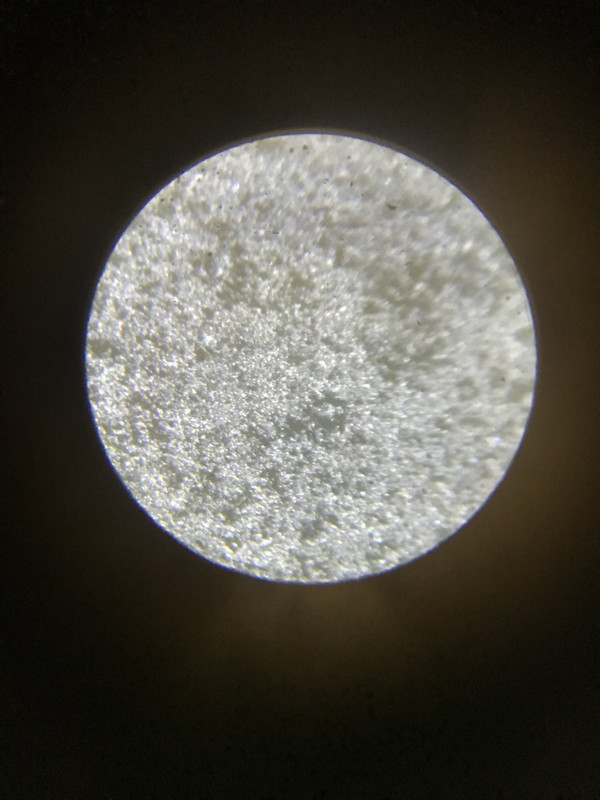 21 February 2020 at 21:06 #11681
21 February 2020 at 21:06 #11681hi Luca, welcome back ! I don't know what to say about abrasive paper instead of silicon carbide, I have never used it but the perplexities that Giulio said a few posts ago are a bit’ mine too…

For the patina of pitch instead, I believe you will immediately notice the lack of beeswax as the friction that will develop in contact with the glass will in all probability be excessive.
The right mix of components is a delicate recipe, which works in a certain temperature range.But I understand you, I've always had a bit of an approach too’ “subversive”, not to say ” Taliban” to consolidated working techniques, in some cases it led me to guess new ways which then proved effective, but in most situations, I would have been better off listening to the texts we all know

So my advice is to try ( in winter ) a patina with bees (35-40 %), rosins (60-65%) , turpentine (little, less than a spoon ) and also linseed oil ( a poor cap of the package ), you will see that it works much better and faster !
22 February 2020 at 12:52 #11682Hi Massimo,
as for the patina of pitch, the percentages you recommend could be fine even if the ambient temperature was around 20 ° / 23 °?
I think I polish the mirror in an environment with these characteristics.I'm not particularly proud of the method chosen.

Initially I thought it was a quick route that I chose but instead I had to change my mind also because I encountered various problems partly due to my inattention to the work done and partly due to lack of experience.
I will certainly adopt more conventional practices in the future.P.S.
Good luck for the development of your new project! 22 February 2020 at 14:43 #11683
22 February 2020 at 14:43 #11683Thanks Luca

The temperature you will have in your work environment is optimal, I believe you can try with quantities 65-35 for pitch and beeswax, always with the minimum quantities of turpentine and linseed oil.
However, I would do a test before casting the casting on the tool.
The “nail test” it is very immediate, it can also be done on a small sample of the casting without necessarily having to build the tool first.
Just be able to leave the nail groove on the patina, doing a little’ pressure for a few seconds.
The furrow generated must be seen but at the same time the surface of the patina must not be deformed or yielded under pressure.
If in addition to the nail imprint, there is a failure is obviously too soft, the amount of turpentine should be reduced and secondly, that of beeswax ( or add more rosin )
If you break your nail, but not even talking about the furrow then turpentine is added and there was bees.
then turpentine is added and there was bees.Linseed oil increases and uniforms smoothness over the entire patina without limiting too much the friction that is necessary, but it should be used with caution.
22 February 2020 at 15:00 #11684well Massimo,
I just have to try and then decide what to do.
These days I'll try the recommended percentages and then I'll let you know.Thank you

-
AuthorPosts
- You must be logged in to reply to this topic.